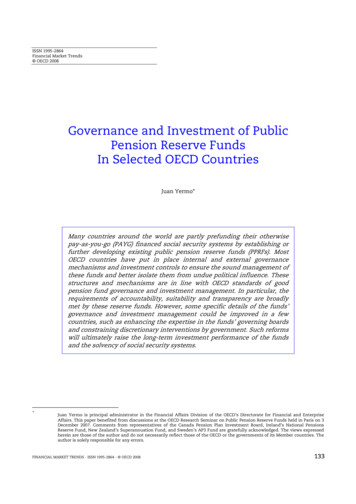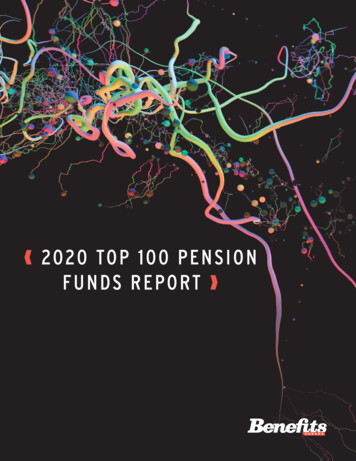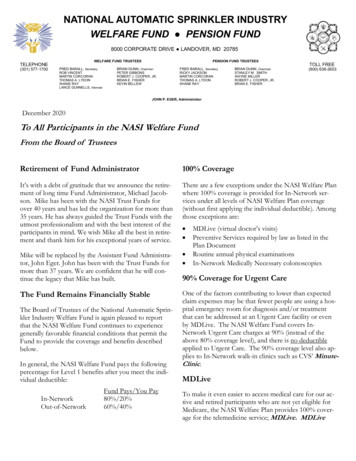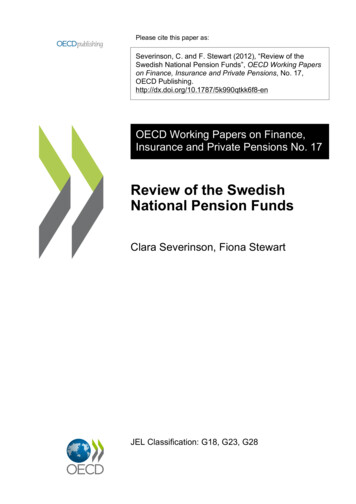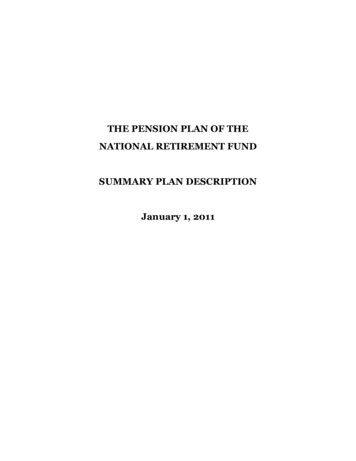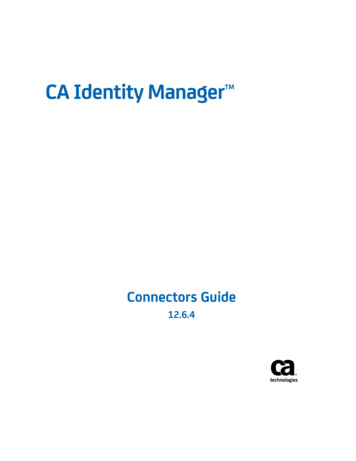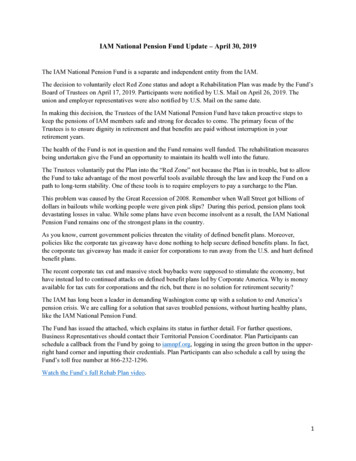
Transcription
IAM National Pension Fund Update – April 30, 2019The IAM National Pension Fund is a separate and independent entity from the IAM.The decision to voluntarily elect Red Zone status and adopt a Rehabilitation Plan was made by the Fund’sBoard of Trustees on April 17, 2019. Participants were notified by U.S. Mail on April 26, 2019. Theunion and employer representatives were also notified by U.S. Mail on the same date.In making this decision, the Trustees of the IAM National Pension Fund have taken proactive steps tokeep the pensions of IAM members safe and strong for decades to come. The primary focus of theTrustees is to ensure dignity in retirement and that benefits are paid without interruption in yourretirement years.The health of the Fund is not in question and the Fund remains well funded. The rehabilitation measuresbeing undertaken give the Fund an opportunity to maintain its health well into the future.The Trustees voluntarily put the Plan into the “Red Zone” not because the Plan is in trouble, but to allowthe Fund to take advantage of the most powerful tools available through the law and keep the Fund on apath to long-term stability. One of these tools is to require employers to pay a surcharge to the Plan.This problem was caused by the Great Recession of 2008. Remember when Wall Street got billions ofdollars in bailouts while working people were given pink slips? During this period, pension plans tookdevastating losses in value. While some plans have even become insolvent as a result, the IAM NationalPension Fund remains one of the strongest plans in the country.As you know, current government policies threaten the vitality of defined benefit plans. Moreover,policies like the corporate tax giveaway have done nothing to help secure defined benefits plans. In fact,the corporate tax giveaway has made it easier for corporations to run away from the U.S. and hurt definedbenefit plans.The recent corporate tax cut and massive stock buybacks were supposed to stimulate the economy, buthave instead led to continued attacks on defined benefit plans led by Corporate America. Why is moneyavailable for tax cuts for corporations and the rich, but there is no solution for retirement security?The IAM has long been a leader in demanding Washington come up with a solution to end America’spension crisis. We are calling for a solution that saves troubled pensions, without hurting healthy plans,like the IAM National Pension Fund.The Fund has issued the attached, which explains its status in further detail. For further questions,Business Representatives should contact their Territorial Pension Coordinator. Plan Participants canschedule a callback from the Fund by going to iamnpf.org, logging in using the green button in the upperright hand corner and inputting their credentials. Plan Participants can also schedule a call by using theFund’s toll free number at 866-232-1296.Watch the Fund’s full Rehab Plan video.1
IAM National Pension FundFAQsActive Participants1. What changes are happening and how will it affect me?The first change required by regulations upon voluntarily electing Red Zone status are theelimination of the lump sum death benefit, social security option, partial lump sum, smallpension benefit, and return to employment lump sum as of April 26, 2019.The changes under the Rehabilitation Plan, are contained in two schedules, the impacts ofwhich are described below: The Preferred Schedule:o Future benefit accruals remain unchanged for participants.o Benefit changes include the elimination of all early retirement pension benefitsubsidies, effective on January 1, 2022.o Adoption of this schedule requires additional employer contributions of 2.5%compounded annually for the length of the Rehabilitation Plan. These additionalcontributions are designed to strengthen the financial health of the Fund and donot count toward benefit accruals.o The Single Life Annuity with 60 Certain Payments option is eliminated. The Default Schedule:o A reduction in future accruals of 39% (Schedule C), effective on the date ofadoption or imposition.o Benefit changes include the elimination of all early retirement pension benefitsubsidies, prospectively only, effective on date of adoption or imposition.o Adoption of this schedule requires additional employer contributions of 6%,compounded annually for the length of the Rehabilitation Plan. These additionalcontributions are designed to strengthen the financial health of the Fund and donot count toward benefit accruals.o The Single Life Annuity with 60 Certain Payments option, the 60 Payments DeathBenefit, and the Pop-Up provision are eliminated.How the Rehabilitation Plan affects you depends upon which Schedule will apply. Thedecision on which Schedule applies to you will be made by your employer and union ifyou are a bargaining unit employee, and by your employer if you are a non-bargainingunit employee.2. What are subsidies within the context of the Plan?
If a plan participant qualifies for 30 and out, 62 and 20, or disability the Fund providesthe participant with 100% of their normal retirement age benefit prior to age 65. Thevalue of the pre-normal retirement age benefit is known as a subsidy, as the moneyreceived by the fund only supported the benefit normal retirement age, not theincreased payout.3. What age is normal retirement age?Assuming you are vested, your normal retirement age is age 65. The Plan’s vesting rulesrequire 5 years of vesting service.4. What does elimination of subsidies mean?The Plan will no longer pay the additional amount required to provide a fully or partiallyunreduced pension benefit prior to Normal Retirement Age. The elimination for thesesubsidies is a key component of the Rehabilitation Plan.Applicability of subsidy elimination depends on, and is described in, the Preferred andDefault Schedules.Examples are contained in the Notice of Reduction in Adjustable Benefits in the mailingand available on the website. Please refer to page 4 of the notice.a. Michael stops working at age 52 with 30 Years of Credited Service. If he were toapply for his pension at age 65, he would receive a Normal Pension benefit of 1,000 per month.b. Under the current Plan, since Michael meets the requirements for a 30 and OutPension, he will receive a benefit of 1,000 per month, beginning at age 52. Thevalue of this subsidization from age 52 – age 65 is 156,000 ( 1,000 * 12 months* 13 years) plus interest. If subsidized unreduced Pensions such as the 30 and OutPension were not available under the Plan, Michael could retire at age 55 with areduced Early Retirement Pension equal to 1,000, reduced by 48% (.004 * 120months) 520 per month. From ages 55 to 65, Michael would receive 62,400( 520 * 12 months * 10 years). Using the unsubsidized Early Retirement ReductionFactors, he would receive 280 per month (as shown in the following paragraph).From ages 55 to 65, he would receive 33,600 ( 280 * 12 months * 10 years).c. Under the Preferred Schedule, if Michael retires at age 52 with a CompletedApplication Date on or after his RP Schedule Effective Date, he will not be eligiblefor a subsidized unreduced 30 and Out Pension. However, he remains eligible tocollect his reduced retirement benefit, calculated by reducing his Normal Pensionat age 65 by 72.0%, after application of the Early Retirement Reduction Factor atage 52 of .280 280. Michael would not be eligible to receive his full retirementbenefit of 1,000 per month unless he delays commencement of his benefit untilage 65.
The elimination for these subsidies is a key component of the Rehabilitation Plan.5. What is meant by retroactive and going forward (prospective)?Retroactive is applicable to benefits earned and accrued in the past. The retroactiveelimination of subsidies applies only to the Preferred Schedule for retirements on orafter January 1, 2022.In the Preferred Schedule, going forward (prospectively) refers to benefits earned andaccrued on or after January 1, 2022. In the Default Schedule, going forward(prospectively) refers to benefits earned or accrued on or after the date of adoption orimposition of that Schedule.6. Why don’t the PPA Surcharges or additional employer contributions count towardsbenefit accruals?PPA Surcharges and additional employer contributions are designed to help improve theFund’s financial health. PPA Surcharges are a requirement for Red Zone plans and arenot applicable to benefit accruals. The additional employer contributions contained inthe two schedules are also required by the Rehabilitation Plan rules and do not apply tofuture benefit accruals.7. What is Schedule C? What does it mean by lower future accruals?Schedule C represents the reduced future accrual requirements under the DefaultSchedule only. The regulatory requirements of a Rehabilitation Plan Default Scheduleinclude reducing all future accruals to 1% of contributions. On average, this represents a39% reduction in future accruals for Plan participants in the Default Schedule.8. Based on this information, I now want to apply for my pension? What do I do?Participants can apply online via the secure participant portal of the website, bysubmitting a written request to the Pension Department at IAM National Pension Fund,1300 Connecticut Avenue, NW, Suite 300, Washington, DC 20036-1711, or I can takeyour information and a Pension Application will be mailed to you.9. Does this impact me if I have already requested an application but not yet submittedit?If you have only requested an application but have not submitted a completedapplication then the payment form changes required by the PPA become effective onApril 26, 2019.
Once a Rehabilitation Plan Schedule is adopted or imposed, the changes required bythat Schedule will be applied.10. What if I’ve submitted my pension application but it is considered incomplete or Ihaven’t received my Participant Statement yet?If your application is considered incomplete or your Participant Statement ispostmarked on or after April 26, 2019, the payment form changes required by the PPAbecome effective on April 26, 2019.Once a Rehabilitation Plan Schedule is adopted or imposed, the changes required bythat Schedule will be applied.11. What if I’ve already submitted a completed application and received my ParticipantStatement?If you have submitted a completed application and your Participant Statement (electionform) was postmarked prior to April 26, 2019, then your benefits will be unaffected bythe changes required on or after April 26, 2019, assuming you return your signedParticipant Statement in accordance with Plan rules.12. Should I expect changes every year now?Generally, you should not expect changes every year. The Rehabilitation Plan isdesigned as a 10-year schedule and is intended to protect the Fund’s participants’ coreretirement benefits and strengthen the Fund’s financial health over the long term.However, the Rehabilitation Plan is subject to change during the 10-year schedule. TheIAM National Pension Fund Board of Trustees is required to review the effectiveness ofthe Rehabilitation Plan periodically. Failure to maintain the 10-year projection towardemergence into the Green Zone may require adjustments to the Rehabilitation Plan inthe future.13. Can the Fund guarantee I will get a pension when I retire?The intent of the Fund is to provide the core retirement benefit at normal retirementage. The Rehabilitation Plan is designed to ensure that we meet those obligations. TheFund, just like all defined benefit plans, does participate in an insurance programdesigned to guarantee a minimum level of benefits.14. What if my employer withdraws from the Fund due to these changes?The Fund has no control over whether employers withdraw from the Fund. That is amatter of discussion for your employer and union if you are covered under a collective
bargaining agreement, and by your employer if you are covered under a participationagreement. However, we believe as a participant you should encourage your employeror union to remain in the Fund as it is currently well-funded and has now put in place aRehabilitation Plan intended to protect the Fund’s participants’ core retirement benefitsand strengthen the Fund’s financial health over the long term.15. What happens to my benefit if my employer withdraws from the Fund?Once your employer withdraws from the Fund, no future benefit accruals will beearned. Assuming you are vested in the Plan, any benefit paid will be based on prioraccruals and Plan rules.16. Will the government bail the Fund out?First, the Fund does not need a bail out. It remains well-funded at 89%. Second, undercurrent laws and regulations, the government does not provide bail outs to multiemployer pension funds. Finally, the Rehabilitation Plan is intended to protect theFund’s participants’ core retirement benefits and strengthen the Fund’s financial healthover the long term.17. Does this have an impact on disqualifying employment rules? Any changes todisqualifying employment rules?No. The Disqualifying Employment rule changes enacted in 2018 remain in place andunchanged.18. How do I participate in the decision to elect a Rehabilitation Plan, Schedule, andeffective date? Who makes the decision in electing a Rehabilitation Plan?If you are covered by a collective bargaining agreement, contact your unionrepresentative. If you are a non-bargaining unit employee covered by a participationagreement, contact your employer.19. When can I get an estimate of my future benefits under the rules of the RehabilitationPlan and Schedules?Benefit estimates are available on the secure participant portal of the website or bysubmitting a written request to the Pension Department at IAM National Pension Fund,1300 Connecticut Avenue, NW, Suite 300, Washington, DC 20036-1711. These estimatesare based upon election of the Rehabilitation Plan and Preferred Schedule. If youremployer and union or employer adopt the Rehabilitation Plan Default Schedule, oncethe Benefit Fund Office is made aware future benefit estimates will be adjustedaccordingly.
Do not forget that you can review your benefits earned to date in your Annual BenefitStatement. These Statements, reflecting 2018 contributions and benefits, will be sentout by late May/early June 2019.20. Can I be grandfathered so that the Rehabilitation Plan Schedule changes don’t impactmy retirement plans? What if I retire by X date – does this still impact me?No, there are no provisions for grandfathering. However, if you retire prior to theadoption or imposition of the Preferred or Default Schedule, current plan rules apply.If you retire after adoption of the Preferred Schedule, early retirement subsidies areeliminated no earlier than January 1, 2022. If you retire before that date you may stillqualify for these subsidies. If you are subject to the Default Schedule, changes will occuron the date of adoption or imposition.21. What does a “Declining Credit Balance” mean?In the years when the Fund brought in more in contributions than it paid out in benefitsa positive credit balance was accumulated. Once the Fund began to pay more in benefitsthan it collected in contributions, the credit balance earned over the years began todecrease. The Rehabilitation Plan is designed to increase the Fund’s credit balance andstrengthen the financial health over the long term.22. When did the Trustees make this decision?The decision to voluntarily elect Red Zone status and adopt a Rehabilitation Plan wasmade by the Board of Trustees on April 17, 2019. Participants were notified by U.S. Mailon April 26, 2019. The union and employer representatives were also notified by U.S.Mail on the same date.23. What is Zone Status and what do you mean the Trustees “voluntarily elected” todeclare Red Zone Status? How is Zone Status decided? Why would the Trusteesvoluntarily elect a lower status?Under the Pension Protection Act, zones are based on certain financial aspects of theFund. Funds are determined to be in one of four zones: “Green” for a healthy plan,“Yellow” for an endangered plan, “Red” for a plan in critical status, and “Deep Red” for aplan considered critical and declining.Under the Multiemployer Pension Reform Act of 2014 (“MEPRA”), Boards of Trusteeshave the option of voluntarily electing Red Zone status to take advantage of the mostpowerful tools available to protect the Fund’s participants’ core retirement benefits andstrengthen the Fund’s financial health over the long term. Based on this tool, the IAMNational Pension Fund Board of Trustees voluntarily elected to declare the Fund in theRed Zone.
24. If the Fund is in the Red Zone doesn’t that mean the Fund is going to cut currentretiree and beneficiary benefits too?Absolutely not. Plans in the Red Zone are not permitted to reduce payments to retireesand beneficiaries.25. What is a Rehabilitation Plan?A Rehabilitation Plan is a legally required plan designed to move Red Zone funds into theGreen Zone within 10 years. Funding Improvement Plans apply to Yellow Zone plans.26. How long is the Rehabilitation Plan in effect?The Rehabilitation Plan, based on reasonable assumptions, projects that the Fund willemerge into Green Zone status within 10 years. Benefit changes to the Plan remain inplace after the Fund emerges from the Rehabilitation Plan into the Green Zone.However, the Board of Trustees does have the right to amend the Plan in the future.27. What if the Rehabilitation Plan and a Schedule are not adopted?If a Rehabilitation Plan and one of the two schedules is not adopted within 180 daysafter your collective bargaining agreement or participation agreement expires, theDefault Schedule will be automatically implemented, and the employer will pay anadditional non-compounding 10% per year, as well as the compounding contributionincreases contained in the Default Schedule and the benefit changes covered under theDefault Schedule will apply.28. What is the contribution increase each year? How will the contribution increase affectmy benefit?First, it is important to understand that all additional contributions made as a result ofthe Rehabilitation Plan, whether Pension Protection Act (PPA) surcharges or Schedulecontribution increases, do not result in future benefit accruals, they are designed toimprove funding only.Prior to adoption of the Rehabilitation Plan, PPA surcharges apply for employers (5%beginning June 1, 2019 and increasing to 10% beginning January 1, 2020).After adoption of the Rehabilitation Plan, the PPA surcharges are eliminated and, if thePreferred schedule is selected, employers begin paying 2.5% compounding annually for10 years. If the Default Schedule is selected, they pay 6% compounding annually for 10years. If the Default Schedule is imposed, they pay the PPA 10% surcharge plus the 6%compounding annually for 10 years.
29. Where does the additional money come from to pay contribution increases? Whopays for contribution increases?Additional contribution increases are the responsibility of the employer.30. How do I get additional information? Is there more information I can read to help meunderstand? Are there other materials that explain all of this?Please visit www.iambfo.org, select the National Pension Fund icon, and log-in to thesecure portion of the website for additional information, including answers to FAQs,explanatory videos, and more.
IAM National Pension FundFAQsDeferred Vested Participants1. I am a Deferred Vested Participant, and my former employer no longer contributes tothe Plan, how does this affect me?Deferred Vested participants who work or worked for an employer that no longercontributes to the Fund (prior to September 1, 2019) will automatically be part of thePreferred Schedule effective September 1, 2019.2. I am a Deferred Vested participant, and my former employer still participates in theFund, how does this affect me?Deferred Vested participants of employers who still participate in the Fund will fallunder the Rehabilitation Plan and Schedule selected by your employer and union if youare covered under a collective bargaining agreement, and by your employer if you arecovered under a participation agreement, effective at the time of election or imposition.3. As a Deferred Vested participant, is there anything I need to do?No, you do not need to do anything.4. When will I know what Schedule is being applied to me, if my employer stillparticipates in the Fund?Please contact your previous union representative or employer for further informationon the timeline they will target for Rehabilitation Plan adoption and Schedule selection.5. What does the Rehabilitation Plan and Schedules mean to me? What are the changesif I fall under the Preferred Schedule or Default Schedule? How many schedules arethere in the Rehab Plan? How are they different?The first change required by regulations upon voluntarily electing Red Zone status arethe elimination of the lump sum death benefit, social security option, partial lump sum,small pension benefit, and return to employment lump sum as of April 26, 2019.The changes under the Rehabilitation Plan, are contained in two schedules, the impactsof which are described below: The Preferred Schedule:
o Future benefit accruals remain unchanged for participants.o Benefit changes include the elimination of all early retirement pension benefitsubsidies, effective on January 1, 2022.o Adoption of this schedule requires additional employer contributions of 2.5%compounded annually for the length of the Rehabilitation Plan. These additionalcontributions are designed to strengthen the financial health of the Fund and donot count toward benefit accruals.o The Single Life Annuity with 60 Certain Payments option is eliminated. The Default Schedule:o A reduction in future accruals of 39% (Schedule C), effective on the date ofadoption or imposition.o Benefit changes include the elimination of all early retirement pension benefitsubsidies, prospectively only, effective on date of adoption or imposition.o Adoption of this schedule requires additional employer contributions of 6%,compounded annually for the length of the Rehabilitation Plan. These additionalcontributions are designed to strengthen the financial health of the Fund and donot count toward benefit accruals.o The Single Life Annuity with 60 Certain Payments option, the 60 Payments DeathBenefit, and the Pop-Up provision are eliminated.How the Rehabilitation Plan affects you depends upon which Schedule will apply. If youare a Deferred Vested participant whose former employer continues to participate inthe Fund, the decision on which Schedule applies to you will be made by your employerand union if you were covered by a collective bargaining agreement, and by youremployer if you were covered by a participation agreement. If you are a DeferredVested participant whose former employer no longer participates in the Fund, thePreferred Schedule will apply effective September 1, 2019.6. What age is normal retirement age?Assuming you are vested, your normal retirement age is age 65. The Plan’s vesting rulesrequire 5 years of vesting service.7. What does elimination of subsidies mean to me?As a Deferred Vested participant, it is unlikely that you would qualify for 30 and out, 62and 20, or disability benefits, unless you have been working in disqualifyingemployment, therefore, the subsidy elimination impact to you is the increase in the agereduction factors applied to an early retirement benefit.The Plan will no longer pay the additional amount required to provide a fully or partiallyunreduced pension benefit prior to Normal Retirement Age. The elimination for thesesubsidies is a key component of the Rehabilitation Plan.
Applicability of subsidy elimination depends on, and is described in, the Preferred andDefault Schedules.Examples are contained in the Notice of Reduction in Adjustable Benefits in the mailingand available on the website. Please refer to pages 3 and 4 of the notice. Example: Steve stops working at age 55 with 15 years of Credited Service and submits hiscompleted pension application. The amount of his monthly Normal Pension if Steve startsreceiving payments at age 65 is 1,000. Under the current Plan, Steve’s Early Retirement Pension is calculated as follows: 1,000, reduced by 48% (.004 * 120 months) 520. Steve would receive an EarlyRetirement Pension of 520 per month if he retires and starts his pensionimmediately at age 55 under the current Plan. Under the Preferred Schedule, Steve’s Early Retirement Pension is calculated asfollows: 1,000, reduced by 63.4%, after application of the Early RetirementReduction Factor at age 55 of .366 366. Steve would receive an Early RetirementPension of 366 per month if he retires and starts his pension immediately at age55 under the Preferred Schedule.8. Am I losing my pension benefits?No. As a Deferred Vested participant, your previously earned, accrued benefits are notlost, although early-retirement subsidies have been retroactively eliminated in thePreferred Schedule. If you return to work with a participating employer, your futurebenefits will be determined by the Rehabilitation Plan and Schedule adopted by youremployer.
IAM National Pension FundFAQsRetirees and Beneficiaries – Benefit Recipients1. I am a current Retiree or Beneficiary collecting a benefit, what does this mean to me?Am I losing my benefits?There is no impact to your retirement benefits.2. I’ve heard Red Zone plans can eliminate retiree benefits. Is this true?No. Plans in the Red Zone are not permitted to reduce payments to retirees andbeneficiaries.3. Aren’t my benefits protected by Law? Is this change legal?Yes, your benefits are currently protected by federal law. None of the RehabilitationPlan changes will affect your benefits. Yes, this change is legal and actually required.4. I understand my benefits are not being affected today, but doesn’t being in the RedZone mean that it’s inevitable that they will be eventually?No, it is not inevitable. The Fund remains well-funded Rehabilitation Plan is designed asa 10-year schedule and is intended to protect the Fund’s participants’ core retirementbenefits and strengthen the Fund’s financial health over the long term.5. What can I do?Since the Rehabilitation Plan has no impact on your benefit payments there is nothingfor you to do.6. How do I get additional information?Please visit www.iambfo.org, select the National Pension Fund icon, and log-in to thesecure portion of the website for additional information, including answers to FAQs,explanatory videos, and more.
IAM National Pension FundFAQsEmployer and Union Representatives1. When is adoption of the Rehabilitation Plan required? Collective Bargaining Agreements:o Bargaining parties must adopt the Rehabilitation Plan and select one of the twoschedules no later than the expiration of the collective bargaining agreementthat was in effect on April 17, 2019 and expires on or after September 1, 2019.o For cases in which CBAs have expired and are still open on September 1, 2019bargaining parties have 180 days from September 1, 2019 to adopt theRehabilitation Plan and one of the two Schedules.o For cases covered by the Railway Labor Act, please contact the EducationDepartment. For Employers, please contact RehabilitationPlan@iamnpf.org. ForUnion representatives, please email questions to Questions@iamnpf.org. Participation Agreements:o When there are both bargained and non-bargained participants at the samelocation: The Rehabilitation Plan adoption date requirement for non-bargainedemployees shall be set as if those non-bargained employees werecovered under the bargaining parties’ CBA at that location in effect on orafter September 1, 2019.o Non-bargained participants only: The Rehabilitation Plan adoption date requirement for non-bargainedemployees who are not related to a CBA shall be set as of January 1,2020.2. Can I adopt the Rehabilitation Plan and Schedule prior to the CBA or PA expiration?Yes. Early adoption provisions allow the employer and union, if collectively bargained, orthe employer if participation is not collectively bargained, to voluntarily adopt theRehabilitation Plan and schedules as early as June 1, 2019 or before your CBA or PAexpires.3. What happens if the Rehabilitation Plan or Schedule is not adopted?If the Rehabilitation Plan and one of the Schedules is not adopted within 180 days afteryour collective bargaining agreement or PA expiration date as described above, the
Default Schedule will be automatically implemented. If the Default Schedule isautomatically implemented employers are then required to pay the 10% PPA surcharge,not compounding, and the 6% employer funding only contributions, compoundingannually, for the duration of the Rehabilitation Plan.4. What is a PPA Surcharge?A PPA Surcharge is a payment made by the employer that is only directed towardsincreasing the funding balance. The surcharge is applied as a percentage above thecurrent contribution rate as required by Federal law for Red Zone plans.5. When does the Employer start paying the PPA surcharge?All participating employers are required by Federal regulation to begin contributing 5%PPA contribution surcharges effective with hours worked on or after June 1, 2019.Absent adoption of the Rehabilitation Plan and Schedules, the PPA contributionsurcharges increase to 10%, effective with hours worked on or after January 1, 2020,and apply continuously until such adoption.6. What if the employer doesn’t pay the PPA surcharges or required Schedulecontribution increases?Employers who do not pay either their PPA surcharge or additional funding-onlyemployer contributions will be subject to collection under the Fund’s delinquencypolicy.7. What are the “Additional employer contributions” contained in the RehabilitationPlan Schedules?These additional contributions, paired with the subsidy eliminations in
IAM National Pension Fund Update - April 30, 2019 The IAM National Pension Fund is a separate and independent entity from the IAM. The decision to voluntarily elect Red Zone status and adopt a Rehabilitation Plan was made by the Fund's Board of Trustees on April 17, 2019. Participants were notified by U.S. Mail on April 26, 2019. The

